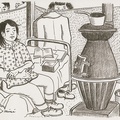Part 3 >>
Robert (Bob) Taro Mizukami
Bob Taro Mizukami was born in 1922 in Star Lake in the hills above Kent, Washington. His mother, Isami, was the youngest sister of Gordon’s father, Shungo, and attended the academy Kensei Gijuku, before emigrating to America. Gordon’s mother, Mitsu, served as an informal “go-between” in his parents’ betrothal. Raised during the Depression, it seemed to Bob that the family was moving almost once a year. The Mizukamis lived and farmed in Thomas right next to cousin Gordon’s farm before moving back to Renton. He and Gordon’s younger brother, Ed, were best friends and together attended the Union Sunday School, festivals in the nearby urban centers of Kent and Auburn, as well as family picnics at Redondo Beach, Washington.
After returning to Renton, Bob attended a church where a Baptist preacher came from Seattle to give sermons. Even though his father was Buddhist, “he believed that all of his kids should have some kind of religious training. So we went to Sunday School and daily Vacation Bible School during the summer.” Bob was baptized in a Baptist Church in Seattle. Today, he attends the Methodist Church just a block down the street from the Buddhist Church in his hometown of Fife, Washington.
The Mizukami family moved from Renton to Fife in 1937. Bob was a sophomore in high school and soon became a part of the high school crowd, attending classes and participating in extracurricular activities. He was interested in sports but was “too small for football, too short for basketball, and even too light to make the ninety-pound weight class in wrestling.” So he got involved in athletics by assisting the coaches as a student manager and earned his varsity letter three years running. He graduated from high school in 1940.
After graduation Bob worked in the family greenhouse business: “Didn’t have much choice in those days.” When the army issued its exclusion orders in the spring of 1942, being the eldest son, he suddenly incurred the responsibility of registering the family with the authorities and preparing the household for the move to camp. May was the height of the bedding season, one of the biggest months in the greenhouse business. “We left everything intact when we left. The War Relocation Authority eventually sold the property {so} we didn’t have any place to come back to after the war.”
On May 15, 1942, the Mizukami family moved to the nearby temporary detention center in Puyallup on army orders. “We had our truck and put all our stuff on it, drove down to Puyallup and unloaded.” In September, they were transferred to the Minidoka camp in southern Idaho. Soon after arriving there Bob signed up for a work furlough and went to harvest potatoes and sugar beets in Aberdeen, Idaho. 29 He returned to camp in time for Christmas, 1942, and found a job working in internal security.
Bob answered “yes, yes” to the critical questions, numbers twenty-seven and twenty-eight, on the so-called “loyalty questionnaire.” “I don’t recall when we filled out the questionnaire, during the time of recruitment or when, but we all had to fill it out. It was an individual thing. It seemed only natural that I answer ‘yes – yes.’ There were ‘no – no’ people, but I was not aware of them at that time.” During early spring 1943, an army team arrived at Minidoka camp to recruit volunteers for the segregated all-Nisei unit, the 442nd Regimental Combat Team (RCT). 30 “Some of us might have talked about signing up, one way of getting out of camp and getting something done. So I went down and signed up. There wasn’t a big debate, should I or shouldn’t I, it just seemed like a natural thing to do when your country is at war.” He didn’t ask his parents for advice: “One thing about my dad, he was a pretty learned person. And so when I told him what I was going to do, he didn’t argue.” Regarding his induction into the army, Bob reiterated his views: “When you take an oath to swear into the service and things like that – those things come home to roost, you know, from the upbringing that you had in the past – like I say, it seems like the natural thing to do.”
Before leaving Minidoka, Bob had told his younger brother Bill, “You stay and take care of the family, I’m going into the service.” Much to his surprise, while training at Camp Shelby, Mississippi, a couple of months later, “Here comes Bill. I said, ‘I thought I told you to stay home!’” There were about two hundred men in a company, which was divided into four platoons. Bill was in the Third Platoon while Bob was in the Headquarters Platoon. They didn’t see much of each other during the day, but spent time together during off hours: “He always seemed to have money and I didn’t, so I used to borrow money from him all of the time.”
After training in a heavy weapons company, “I ended up in the kitchen. I don’t know what decided me, but they were looking for volunteers to go into the kitchen.” Bob became a mess sergeant. The brothers shipped out together and were involved in the Rome-Arno Campaign in 1944. In early July, they crossed Cecina River and were a little south of Arno River, advancing to a place called Hill 140 (“Little Casino”):
The Germans were using the Leaning Tower of Pisa as a field artillery observation post and they had us pinned down for awhile. I saw Bill one night, we were hauling hot meals up to the line. I was talking to him, and he was telling me some of those shells are getting awfully close. So I was kidding him, what do you want me to tell them when I get home. Man, I can still remember saying that, what a smart-ass thing to say. I keep thinking about that all of the time. He was caught in a mortar barrage, killed in his own foxhole.
Bob stayed with the 442nd RCT throughout the European campaign. Some of the more memorable battles he participated in were the liberation of Bruyeres, the Lost Battalion battle, where the 442nd RCT lost more men than the Texans they saved, and the critical breaking of the Gothic Line. 31 It was during the liberation of Bruyeres that Bob earned a purple heart: “A couple of mortar shells came over … hit about 10 feet away … got shell fragments and drew blood.”
After eighteen months in Europe, Bob returned to the United States and was discharged at Fort Lewis, Washington in December 1945. Meanwhile, his family had left Minidoka camp on a work furlough program and were then working in a nursery in Spokane. During the summer of 1946, the family went back to Fife on a vacation and visited the old homestead. “We made a deal to buy the place back; paid twice as much as when we bought it before the war.” Together with his parents and younger siblings, they resumed the family business. Bob got married, raised a family, and ran a successful greenhouse business.
In 1956, a rumor floated around that the city of Tacoma wanted to annex Fife. Some of the locals wished to maintain their autonomy, and Bob became a member of the original incorporating committee. After incorporation he was elected to the original city council. In 1980, when the incumbent mayor was elected the county commissioner, the city council elected Bob as mayor pro tem. Subsequently, he was elected to serve an additional four-year term. “I had a total of seven years. At the end of 1987, I was sixty-five at that time, I decided that’s enough. During that period, there was no other Nisei elected to a political office in the State of Washington.”
Bob served thirty years in local politics. He is retired and lives in Fife with his wife, Lily. His son Greg now runs the family business.
Notes:
I would like to thank Ako Wooley for her translations of Issei writing; Louis Fiset, Gail Nomura, and Lane Hirabayashi for insightful feedback; and the four cousins, Grant, Gordon, Bob, and Hank, for sharing their lives with the community. The author is a member of the Hirabayashi kin group and the younger brother of Gordon Hirabayashi.
29. Louis Fiset, “Thinning, Topping, and Loading: Japanese Americans and Beet Sugar in World War II,” Pacific Northwest Quarterly 90, no. 3 (summer 1999), 123-39.
30. For information on the 442nd RCT, see Thelma Chang, I Can Never Forget: Men of the 100th /442nd (Honolulu: University of Hawaii Press, 1992) and Masayo Duus, Unlikely Liberators: The Men of the 100th and the 442nd (Honolulu: University of Hawaii Press, 1987).
31. For a description of these battles, see Chester Tanaka, Go for Broke: A Pictorial History of the Japanese American 100th Infantry Battalion and the 442nd Regimental Combat Team (Richmond, Calif.: Go For Broke, Inc., 1982).
* This article was originally published in Nikkei in the Pacific Northwest: Japanese Americans & Japanese Canadians in the Twentieth Century , edited by Louis Fiset and Gail M. Nomura (University of Washington Press, 2005) and reprinted with permission.
** In preparation of the Enduring Communities National Conference (July 3-6, 2008 in Denver, CO), we are posting an essay by James Hirabayashi that was originally published in the book, Nikkei in the Pacific Northwest: Japanese Americans and Japanese Canadians in the Twentieth Century. James Hirabayashi will present a dramatic reading about these four cousins at the National Conference titled, "Four Hirabayashi Cousins: A Question of Identity on July 3 and 4, 2008." Enduring Communities is a project of the Japanese American National Museum.
© 2005 James A. Hirabayashi






